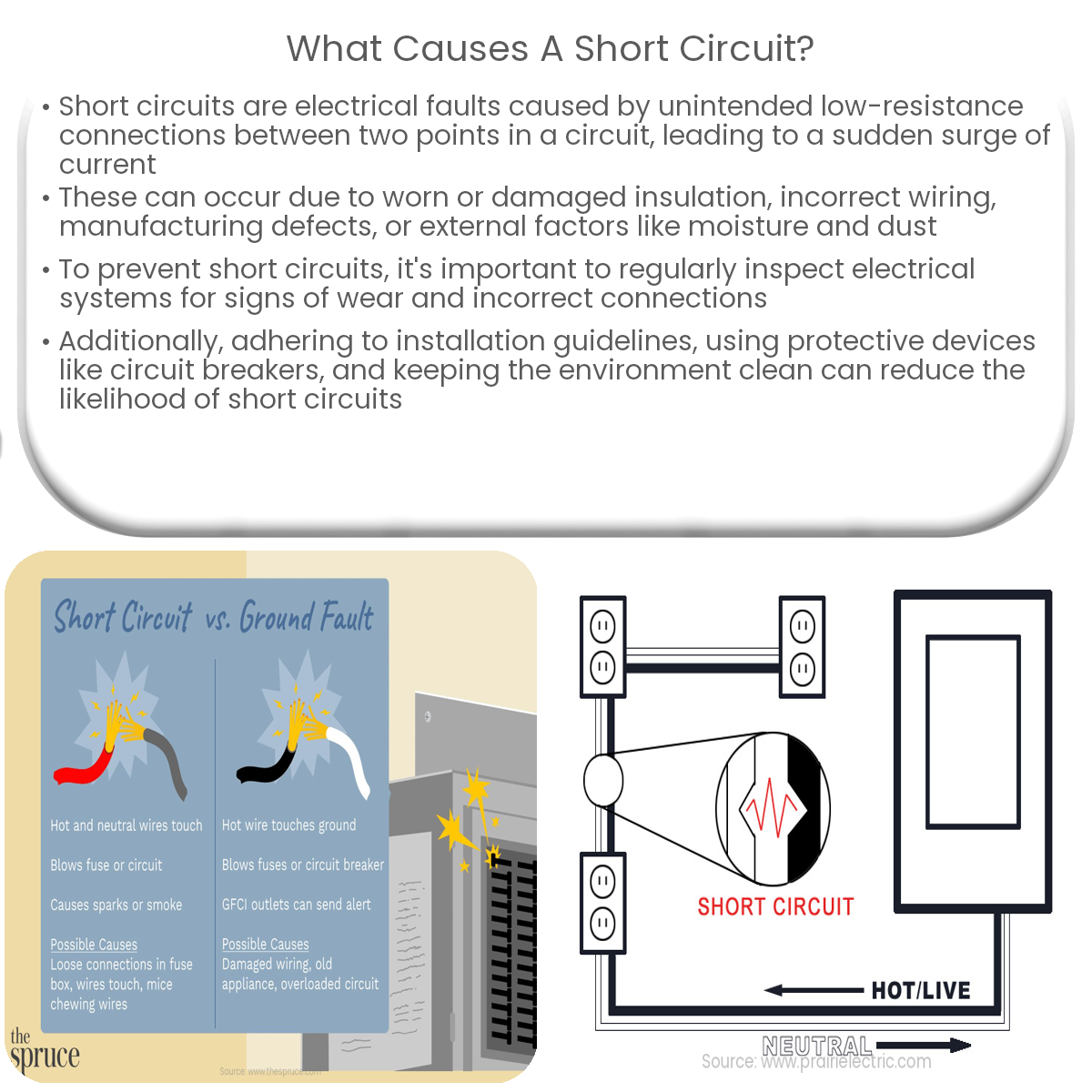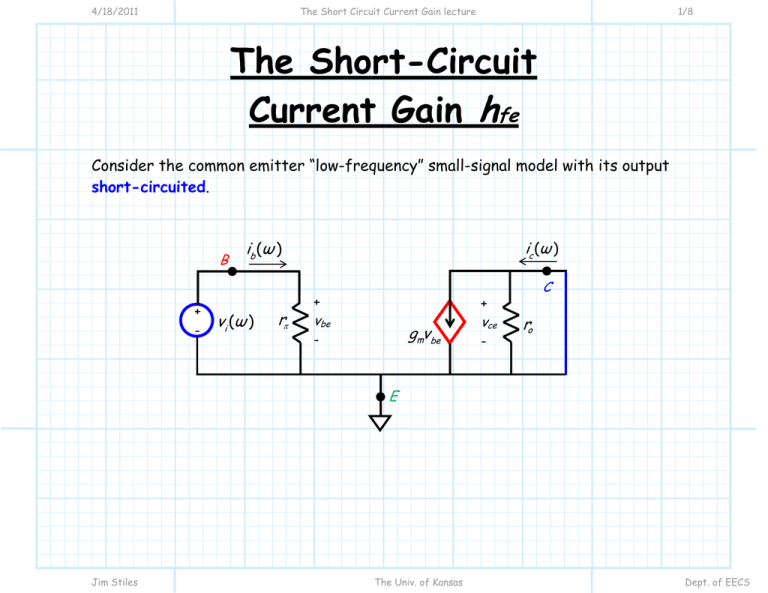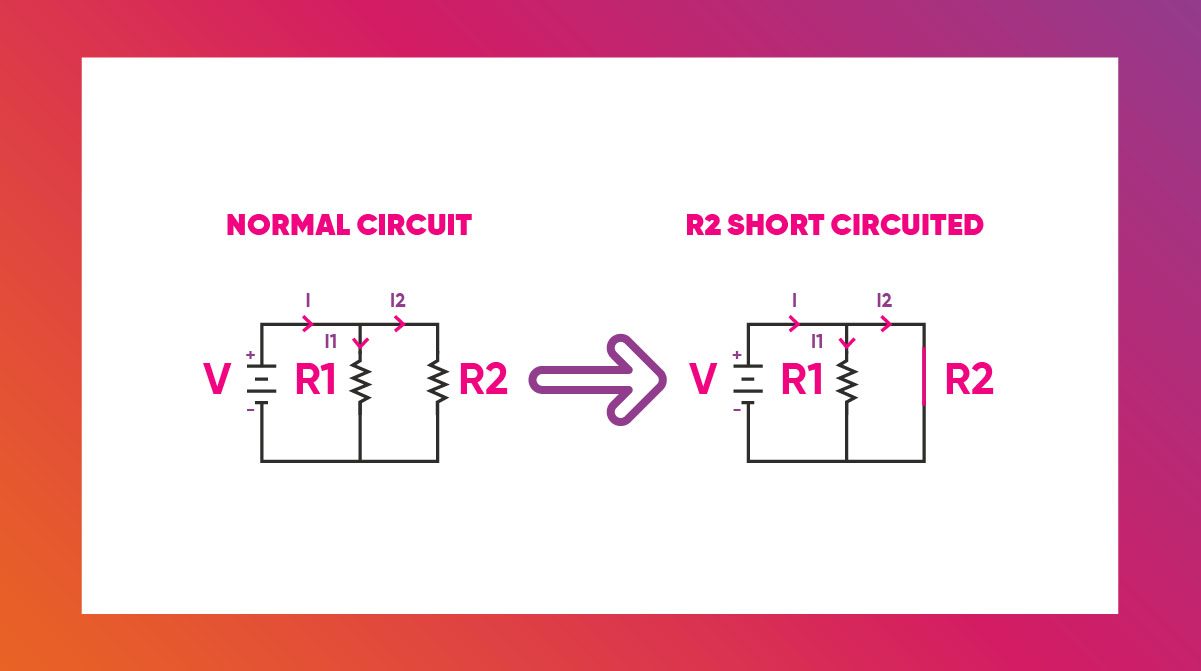Inspirating Tips About What Happens To The Current In Short Circuit

¿Qué Causa Un Cortocircuito?
The Perilous Path of Least Resistance
1. Understanding the Basics
Ever wondered what happens when your electrical system throws a tantrum? We're talking about a short circuit, that electrical gremlin that can cause sparks to fly (literally!). At its core, a short circuit is all about the flow of electric current. Think of it like water finding the easiest route downhill. In a well-behaved circuit, the current diligently follows its designated path, powering your devices along the way. But when things go awry, it's a whole different story.
Normally, electrical current is forced to travel through a circuit's components — resistors, light bulbs, motors, the works. These components offer resistance, which is like a toll booth on the highway of electrons. This resistance limits the amount of current flowing. But what happens if the current finds a shortcut, bypassing those toll booths altogether? That, my friends, is where the short circuit saga begins.
Imagine a frayed wire accidentally touching a neutral wire. Boom! You've created a super-low-resistance path. The current, always eager to take the easy way out, abandons its usual route and surges through this new shortcut. Its like discovering a secret passage that lets you skip all the traffic on your commute. Sounds great, right? Well, in the electrical world, it's a recipe for disaster.
This sudden, massive flow of current is what makes short circuits so dangerous. We're not talking a polite little stream of electrons; we're talking a raging torrent, like Niagara Falls unleashed within your wiring. And that kind of power surge can cause all sorts of problems, from melted wires to full-blown electrical fires. So, understanding what's happening to the current is crucial for safety.

The Current's Wild Ride
2. The Chain Reaction
So, the current has found its shortcut and is now zooming through the circuit at breakneck speed. But what happens next? Well, first off, because there's little to no resistance in the shortcut, the amount of current skyrockets. Think of it like opening the floodgates on a dam. All that pent-up electrical energy is suddenly released.
This excessive current causes the wires to heat up, and fast. Remember, electrical resistance generates heat, like rubbing your hands together quickly. In a normal circuit, the heat is manageable. But in a short circuit, the heat is intense enough to melt the insulation around the wires, potentially exposing bare conductors and creating an even greater fire hazard. Its like cooking your wires from the inside out.
The heat isn't the only problem. The surge of current can also damage components in the circuit. Think of it like trying to force too much water through a pipe — eventually, something's going to burst. In an electrical circuit, that "bursting" can manifest as blown fuses, tripped circuit breakers, or even damaged appliances. Its not a pretty sight, and its certainly not something you want happening in your home.
Thats why safety devices like fuses and circuit breakers are so important. They're designed to detect these overcurrent conditions and quickly interrupt the flow of electricity, preventing further damage or injury. They are the unsung heroes that protect us from our electrical system's occasional meltdowns. So, always make sure your electrical panel is up to date and functioning properly. It could save your life!

Why Do Short Circuits Happen? 2024 Best Answer
Safety Measures
3. Your Electrical Protectors
Let's talk about our electrical guardians: fuses and circuit breakers. These little devices are designed to be the first line of defense against the dangers of a short circuit. They're like the bouncers at an electrical nightclub, keeping the unruly current in check. But how do they work?
Fuses contain a thin wire that melts when the current exceeds a certain level. Its like a sacrificial lamb that gives its life to protect the rest of the flock. When the wire melts, it breaks the circuit, stopping the flow of electricity. Circuit breakers, on the other hand, use a mechanical switch that trips open when the current gets too high. They can be reset after the problem is resolved, making them a bit more convenient than fuses.
It's incredibly important to understand the role of these protectors and to never bypass them. It can be tempting to replace a blown fuse with one of a higher amperage rating, but this is a dangerous practice. It's like removing the bouncer from the nightclub — things are bound to get out of control. Always replace a blown fuse or tripped breaker with one of the same rating.
Beyond fuses and breakers, common sense plays a huge role in preventing short circuits. Regularly inspect your cords and appliances for any signs of damage, such as frayed wires or cracked insulation. Avoid overloading electrical outlets and extension cords. And if you're not comfortable working with electricity, always call a qualified electrician. Its better to be safe than sorry — especially when dealing with potentially lethal currents.

Spotting the Signs
4. Identifying the Problem
Knowing the warning signs of a short circuit can help you avoid a more serious problem. After all, early detection is key. So, what should you be looking for? One of the most obvious signs is a burning smell coming from an outlet or appliance. That's a clear indication that something is overheating, and it's definitely time to investigate.
Another telltale sign is frequently tripping circuit breakers or blowing fuses. If you find yourself constantly resetting a breaker or replacing a fuse, there's likely an underlying issue. Don't just keep resetting the breaker — that's like ignoring the smoke alarm while your house is on fire. Get a qualified electrician to check things out. There is probably a short circuit.
Pay attention to flickering lights or appliances that aren't working properly. These could be signs of a loose connection or a developing short circuit. Also, be wary of outlets that are hot to the touch or have scorch marks around them. These are red flags that should not be ignored. Do not ever ignore any outlets like this!
Remember, electricity is a powerful force that should be treated with respect. If you suspect a short circuit, turn off the power to the affected area immediately and call a qualified electrician. Don't try to fix it yourself unless you have the necessary knowledge and experience. When it comes to electricity, its always best to err on the side of caution.

Simple Way To Calculate Short Circuit Current Using Point
The Aftermath
5. Recovery and Prevention
Okay, so you've had a short circuit, and hopefully, you've managed to contain the damage. Now what? Well, the first step is to identify and fix the underlying cause of the short. This might involve replacing damaged wiring, repairing faulty appliances, or addressing overloaded circuits. The goal is to prevent the problem from recurring.
It's also a good idea to have a qualified electrician inspect your electrical system to ensure that everything is in good working order. They can identify any potential hazards and recommend necessary repairs or upgrades. Think of it like getting a checkup after a serious illness — it's always better to be thorough.
Once the repairs are complete, take steps to prevent future short circuits. Avoid overloading circuits, use surge protectors to protect your sensitive electronics, and regularly inspect your cords and appliances for any signs of wear and tear. Its a bit like taking preventative medicine for your home's electrical system.
Short circuits are a serious electrical problem that can have dangerous consequences. By understanding what happens to the current during a short circuit, recognizing the warning signs, and taking appropriate safety measures, you can protect yourself, your family, and your home from the potentially devastating effects of electrical faults. Stay safe, and keep those circuits humming smoothly!
